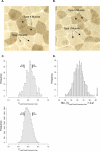Transcriptional profiling of aging in human muscle reveals a common aging signature
- PMID: 16789832
- PMCID: PMC1513263
- DOI: 10.1371/journal.pgen.0020115.eor
Transcriptional profiling of aging in human muscle reveals a common aging signature
Abstract
We analyzed expression of 81 normal muscle samples from humans of varying ages, and have identified a molecular profile for aging consisting of 250 age-regulated genes. This molecular profile correlates not only with chronological age but also with a measure of physiological age. We compared the transcriptional profile of muscle aging to previous transcriptional profiles of aging in the kidney and the brain, and found a common signature for aging in these diverse human tissues. The common aging signature consists of six genetic pathways; four pathways increase expression with age (genes in the extracellular matrix, genes involved in cell growth, genes encoding factors involved in complement activation, and genes encoding components of the cytosolic ribosome), while two pathways decrease expression with age (genes involved in chloride transport and genes encoding subunits of the mitochondrial electron transport chain). We also compared transcriptional profiles of aging in humans to those of the mouse and fly, and found that the electron transport chain pathway decreases expression with age in all three organisms, suggesting that this may be a public marker for aging across species.
Conflict of interest statement
Competing interests. The authors have declared that no competing interests exist.
Figures





References
-
- Butler RN, Sprott R, Warner H, Bland J, Feuers R, et al. Biomarkers of aging: From primitive organisms to humans. J Gerontol A Biol Sci Med Sci. 2004;59:B560–B567. - PubMed
-
- Miller RA, Chrisp C, Galecki A. CD4 memory T cell levels predict life span in genetically heterogeneous mice. FASEB J. 1997;11:775–783. - PubMed
-
- Rodwell GE, Sonu R, Zahn JM, Lund J, Wilhelmy J, et al. A transcriptional profile of aging in the human kidney. PLoS Biol. 2004;2:e427. DOI: 10.1371/journal.pbio.0020427. - DOI - PMC - PubMed
Publication types
MeSH terms
Substances
Grants and funding
LinkOut - more resources
Full Text Sources
Other Literature Sources
Medical
Molecular Biology Databases

